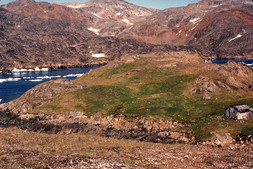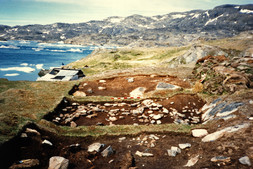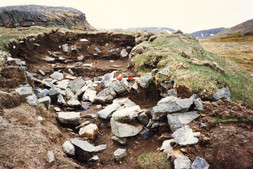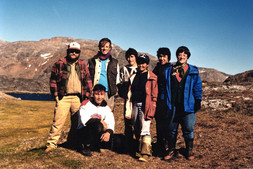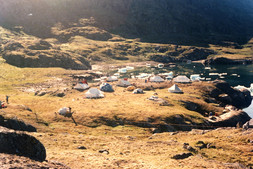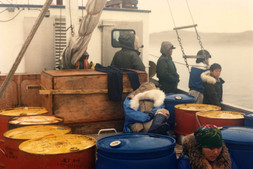- About
- Discovering Archaeology
- Projects and Activities
- Online Resources
- References
Archaeology
Site JcDe-1: Nunaingok (Ikirasaq)
1987-1988Site description
Site JcDe-1 is located on a long peninsula between Ikirasaq and Tunusuarjuk, in the far northeast of the Nunavik-Labrador peninsula, roughly 9 km southeast of the community of Killiniq (Port Burwell). The site covers most of the small peninsula and includes several semi-subterranean dwellings, mostly qarmait [def], a type of dwelling used in the region in historic times.
History
Archaeologists have known of this site, inhabited over a period of at least 3,500 years, since the late 19th century thanks to the observations of Robert Bell, a geologist with the Geological Survey of Canada. In 1934, Douglas Leechman (1945) spent several weeks here, working on the excavation a dwelling. Two smaller research efforts were carried out in 1977 and 1978.
In 1985, site JcDe-1 was selected with regard to the expectations of Nouveau-Québec’s Inuit in their efforts to protect and conserve the heritage of the region’s contemporary inhabitants. The site was proposed as an advanced “excavation school” for Inuit students. The proposal was accepted in 1987.
Archaeological excavations
In 1987 and 1988, the Avataq Cultural Institute and a team of Japanese archaeologists carried out wide-ranging excavations to document the cultural history and human settlement of the area. This work resulted in the collection of thousands of artifacts and information pertaining to the construction of qarmait on the site, as well as its prior habitants. Thus, almost 4,000 years of history, from the Pre-Dorset Era [def.] to the 1930s, were documented. The site, in its capacity as an excavation school, also provided Inuit students with advanced training in archaeological fieldwork.
Contact: Daniel Gendron

